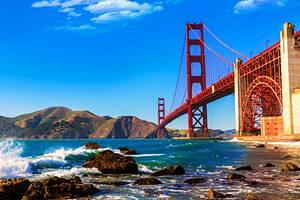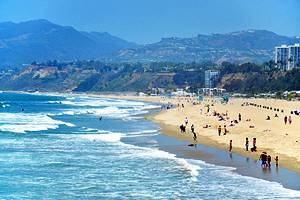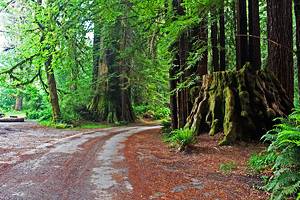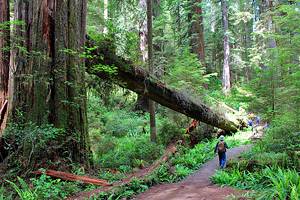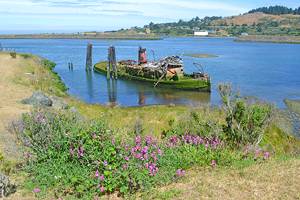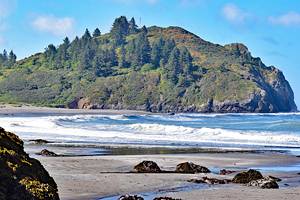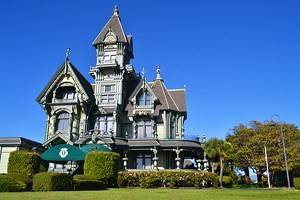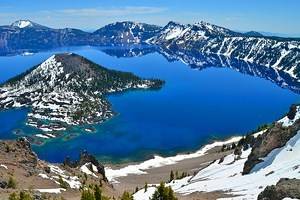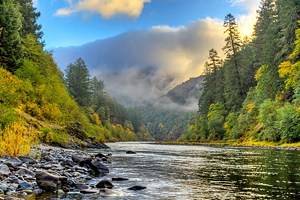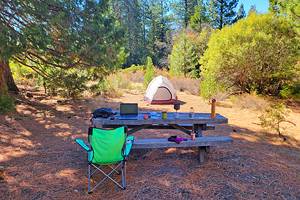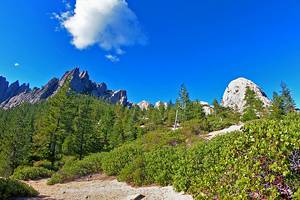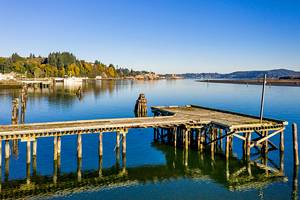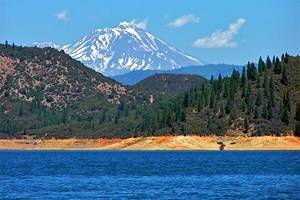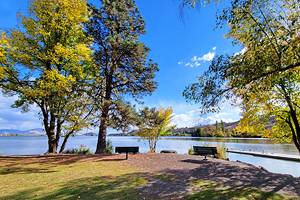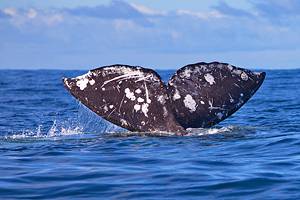Things to Do in Crescent City, CA
Crescent City is a unique town far along the Northern California coast, near the Oregon border on Highway 101. It's a city bounded by coastal redwoods and an ocean occasionally swept by fog. These picturesque environments are reason alone to visit. Among the scenic landscapes are boats atop the water, ancient groves of attraction, and a lighthouse cutting through the fog.
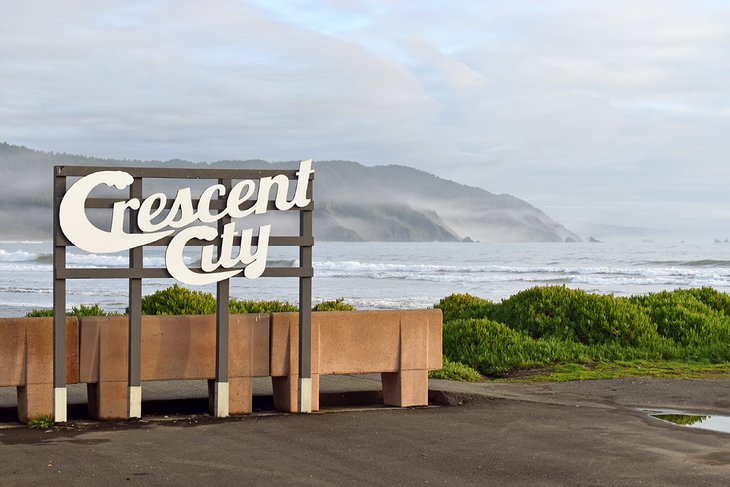
But this serene landscape isn't always so peaceful, as its low-lying stature has brought tsunamis past its shore. Most notably, a 1964 tsunami rocked the city, tragically killing eleven people and leveling 27 city blocks. This massive wave forever changed the downtown landscape. Today, interpretive information throughout the city details the history of these semi-frequent natural disasters.
Crescent City is at the northern end of the Redwood Highway, making it a popular pit stop along this bucket-list scenic drive. Within five miles of the downtown district, Jedediah Smith Redwoods State Park is the closest access point to these ancient trees. This proximity includes access to the historic Howland Hill Road, once used as a stagecoach route.
Explore the ocean and the redwoods and everything in between with our list of the top things to do in Crescent City, California.
- Visit the Battery Point Lighthouse & Museum at Low Tide
- Explore the Redwoods at Jedediah Smith Redwoods State Park
- Wander from Beach Front Park to B Street Pier
- Tour the Crescent City Harbor District
- Explore the Seaside at Crescent Beach
- Take the Tsunami Walking Tour
- Stroll the Shore at Pebble Beach
- Dive into Ocean World
- Visit the Brother Jonathan Cemetery
- Travel the Redwood Highway
- Map of Things to Do in Crescent City, CA
- Crescent City, CA - Climate Chart
Visit the Battery Point Lighthouse & Museum at Low Tide

Battery Point Lighthouse occupies a tiny island just off the city's southwest shore. This active navigation aid has warned mariners of the rocky coast for over 160 years. And depending on the tide, visitors can tour the historic lighthouse and grounds.
Because of its island status, the lighthouse is only accessible during low tide, when the ocean recedes to reveal a 200-foot stretch of road. Tours are offered throughout the year, and the Del Norte County Historical Society schedules tours based on the tides.
If the tide timing isn't right, the beach opposite the lighthouse offers an excellent seaside scene to enjoy. And with its western orientation, it's a beautiful area come sunset. Extending in either direction, Crescent City's Coastal Trail allows Battery Point Lighthouse to be one of many scenic spots in a day of exploring.
Official site: https://delnortehistory.org/
Explore the Redwoods at Jedediah Smith Redwoods State Park

Crescent City's closest access point to Redwood Country is Jedediah Smith Redwoods State Park, opposite the ocean from the city. This 10,000-acre state park is the northernmost unit of Redwoods National and State Parks, and it's accessible with less than a five-mile drive from downtown.
Among its many acres, Jedediah Smith is home to approximately seven percent of the last remaining old-growth redwoods in the world. These magnificent trees flourish in the low coastal environment, some growing over 300 feet tall and outdating Christopher Columbus by more than 1,000 years.
No roads travel through the heart of the park. U.S. Route 199, which connects Crescent City to Grants Pass, Oregon, cuts through the park's northern section. Highway 199 is a common choice for commuters, but those wanting to explore the park should opt for the historic Howland Hill Road.

Howland Hill Road diverts from Highway 199 and cuts through the southern portion of the park. It's a 10-mile narrow dirt road that's not suitable for RVs or trailers. Trailheads like Stout Grove, Grove of Titans, and Boy Scout Tree Trail line this historic route and offer some of the best hiking in Redwoods National and State Parks. Much of the road is wide enough for only a single vehicle, with several places to pull out and let opposing traffic pass.
Official site: https://www.parks.ca.gov/?page_id=413
Wander from Beach Front Park to B Street Pier

Much of the city's seaside splendor sits between Beach Front Park and the B Street Pier. This public land south of downtown offers abundant green space and parking alongside endless ocean views. It's a pleasant place to visit for a walk or to park the car and take in the saltwater scene.
At the western end of the park, the B Street Pier extends approximately 900 feet into the water. This long pier offers a fantastic view of the city's shoreline, including the Crescent City Harbor and Battery Point Lighthouse. Although the high fishing expectations of the pier never fully surfaced, it's still a scenic spot to cast a line, and crabbing is bountiful throughout the first half of the year.
The pier is next to the even longer lighthouse jetty. This wave breaker helps protect Crescent City from tsunami events. Walking on the jetty is not permitted (and not safe), but it's fun to watch the waves pound against the reinforced breakwater. Next to the gated entrance of the jetty, visitors access the beach that leads to Battery Point Lighthouse.
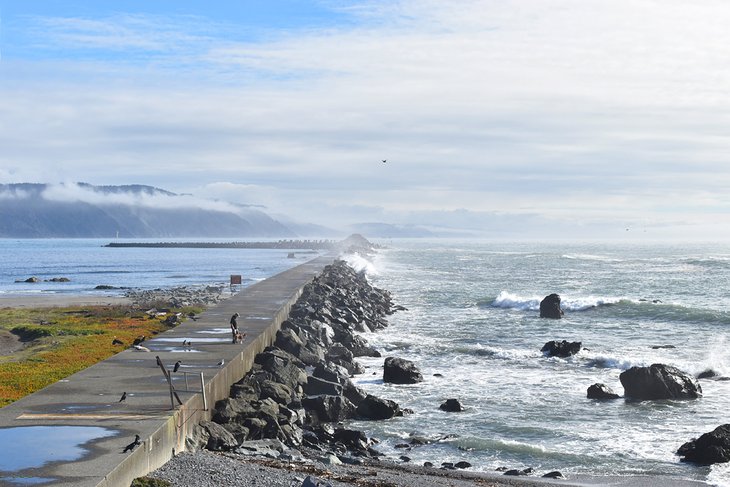
Near Battery Street and the beachfront, the Northcoast Marine Mammal Center (NMMC) offers a nice side trip on a leisurely day. This non-profit organization specializes in marine mammal rescue and rehabilitation. During public operating hours, visitors can tour the area and witness some of the resident animals. A gift shop on-site helps support the NMMC mission.
Tour the Crescent City Harbor District

On the south side of town, off the 101, Crescent City Harbor is a bustling place of rebuilt community attractions. A 2011 tsunami event put the Inner Boat Basin underwater. Still, the area has bounced back to provide a fun visiting experience.
The California Coastal Trail picks up near the newly built boat basin, where various vessels find safe harbor. Among the floating fleet are fishing charters and commercial fishing vessels. Here, photographers will enjoy the selection of boats atop the water, especially come sunset. This is also the place to hop aboard a chartered fishing boat trip.
South of the boat basin is the Harbor District proper. Visitors find three restaurants within the district, including the notable Chart Room on Anchor Way next to the water. This popular seafood restaurant has fresh menus for all three meals of the day. It also has a vocal colony of sea lions that frequent a nearby floating dock.

Crescent City Harbor is also home to the Crescent City Farmers Market on Saturdays between June and October. For those traveling by boat, plenty of guest moorage is available. Consult the official website for rates. Daily, weekly, monthly, and annual rates are available for recreational watercraft.
Official site: https://www.ccharbor.com/
Explore the Seaside at Crescent Beach

Crescent Beach is directly south of Crescent City, encompassing a long semicircle of sandy shoreline. The main beach access is approximately halfway down Enderts Beach Road, accessible off the 101 with a 10-minute drive from town.
It's a popular spot for beach walking and enjoying the salty air. Occasionally, surfers show up to ride the moderate but long waves. Several pieces of driftwood line the shoreline, offering plenty of places to sit and find a little protection on windy days.
When in the area, take the time to drive the other half of Enderts Beach Road up to the Crescent Beach Overlook. Here, on clear days, the view includes the entire arch of the beach leading to Crescent City Harbor. The road ends just beyond the overlook, where a hiking trail leads farther south to Enderts Beach, part of Del Norte Coast Redwoods State Park.
Take the Tsunami Walking Tour

In March of 1964, a 9.2 magnitude earthquake crumbled the streets of Anchorage, Alaska. That same tremor sent a shockwave resulting in a devastating tsunami in Crescent City. The largest wave to strike downtown killed eleven people and washed out 27 city blocks.
Today, visitors can learn about this turning point in the city's history via the Tsunami Walking Tour. This self-guided tour navigates the oceanfront and downtown with interpretive markers along the way. Along the trail, each marker paints a picture of the worst tsunami disaster recorded in U.S. history.
The Tsunami Walking Tour also dives into the city's broader big-wave history. While the 1964 tsunami was the most tragic, it certainly isn't the only water to cause destruction. Over 30 tsunamis have been recorded in Crescent City since the 1930s, including a 2011 event that swept away the harbor's boat basin.
Stroll the Shore at Pebble Beach
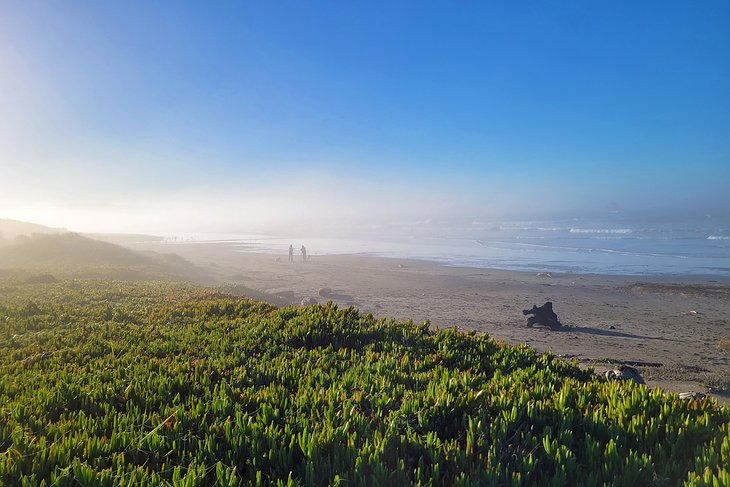
Pebble Beach is a long stretch of sand north along the coast from downtown. It's a vast expanse, with parking available a few miles down Pebble Beach Drive after the road descends a cliffside.
Pebble Beach is a popular spot for several beach activities, including simply walking next to the water. Several parking spots have ocean views, making it a viable place to kill the engine and enjoy lunch in or near the car.
North along the beach, and less than a mile offshore, Castle Rock National Wildlife Refuge offers a haven for all sorts of marine birds. Bring some binoculars or a telephoto lens to watch birds riding the airwaves above the ocean.
Dive into Ocean World
Ocean World is a popular tourist attraction off the 101 in Crescent City. It features over a half-million gallons of underwater exhibits, including several interactive experiences. This aquarium dates back to 1964 when it was in the Crescent City Harbor on a floating barge known as Under Sea Gardens.
Today, a guided tour is the only way to meet and touch the sea life at the property. These 45-minute tours start every 15 minutes throughout the day, seven days a week (excluding holidays). The tour guides offer an entertaining and informative experience. Tours typically begin with a Touch and Feel Tidepool Tank and conclude with a seal or sea lion performance.
After the tour, consider spending time at Ocean World's extensive gift shop. Here, a large selection of T-shirts, stickers, and other collectible items commemorate time spent in Del Norte County.
Address: 304 Highway 101 South, Crescent City, California
Official site: https://oceanworldonline.com/
Visit the Brother Jonathan Cemetery
This historical marker commemorates the many lives lost aboard the S.S. Brother Jonathan, which sank in the nearby waters on July 30th, 1865. An estimated 200-plus passengers perished that day, making it the worst maritime disaster in history on the U.S. Pacific Coast.
Today, 22 headstones comprise the cemetery at Brother Jonathan Park. Interpretive information dives into greater detail on the tragedy that unfolded over 150 years ago.
Head to the downtown Del Norte County Historical Society for more information on the Brother Jonathan shipwreck and other regional history accounts. Here, a few other notable exhibits detail the 1964 tsunami and the native Tolowa and Yurok peoples.
Travel the Redwood Highway

Crescent City is often a pitstop for those traveling the Redwood Coast of Northern California. The city is near the north end of Redwoods National and State Parks, next to Jedediah Smith Redwoods State Park. And heading south, following the Redwood Highway, it's a tall and wondrous world to explore.
The collective Redwood National and State Parks protect over 130,000 acres of coastal redwood habitat. Del Norte Coast and Prairie Creek Redwoods State Parks, south of Crescent City, are also under joint management. These two seaside state parks are less than an hour from downtown, and both illustrate the beauty of big trees next to the ocean.
The Redwood Highway extends for a total of 175 miles between Crescent City and Leggett. Big trees abound all along this route, clustered into individual groves. Humboldt Redwoods State Park is another notable grove to aim for, two hours south of Crescent City, and home to the Avenue of the Giants.

It's not just big trees that draw attention to the redwoods of California. The entire coastal environment is stunning to explore. Other notable landscapes include verdant river canyons, vast coastal scenes, and wild elk habitats. Near Gold Bluffs Beach in Prairie Creek Redwoods State Park, Fern Canyon is one unique spot that displays a little bit of everything.
Official site: https://www.nps.gov/redw/index.htm
Read More:
Map of Things to Do in Crescent City, CA
Crescent City, CA - Climate Chart
| Average minimum and maximum temperatures for Crescent City, CA in °C | |||||||||||
| J | F | M | A | M | J | J | A | S | O | N | D |
| 12 4 | 12 5 | 13 6 | 14 6 | 16 8 | 17 9 | 18 10 | 19 11 | 19 9 | 17 7 | 14 6 | 12 4 |
| PlanetWare.com | |||||||||||
| Average monthly precipitation totals for Crescent City, CA in mm. | |||||||||||
| 258 | 233 | 234 | 130 | 80 | 40 | 10 | 19 | 42 | 116 | 250 | 285 |
| Average minimum and maximum temperatures for Crescent City, CA in °F | |||||||||||
| J | F | M | A | M | J | J | A | S | O | N | D |
| 54 40 | 54 41 | 55 42 | 57 43 | 60 46 | 63 48 | 65 50 | 66 51 | 66 49 | 63 45 | 57 42 | 54 39 |
| PlanetWare.com | |||||||||||
| Average monthly precipitation totals for Crescent City, CA in inches. | |||||||||||
| 10 | 9.2 | 9.2 | 5.1 | 3.1 | 1.6 | 0.4 | 0.7 | 1.7 | 4.6 | 9.8 | 11 |


